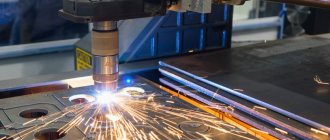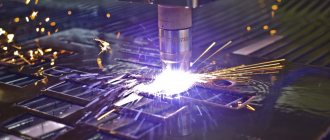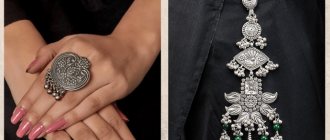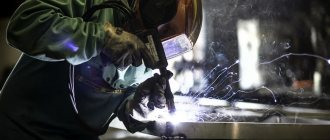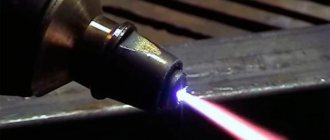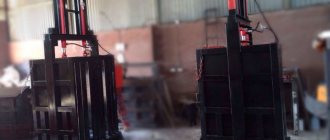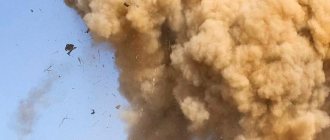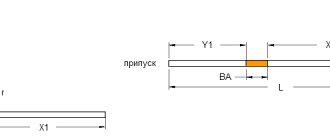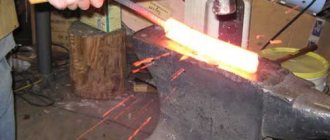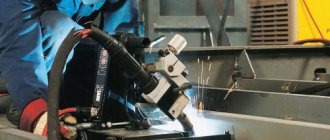02/27/2019 Author: VT-METALL
Issues discussed in the material:
- What role does the metal pressing method play in modern industry?
- What does metal pressing technology involve?
- What types and methods of metal pressing exist?
- What types of industrial equipment are there that are used for metal pressing?
Today, stamping is increasingly used in metal processing, which requires pressing the metal. Using this technological process, the workpiece is given the required shape, namely, a certain relief, patterns are extruded, or holes are punched.
The role of metal pressing method in modern industry
Metal pressing is a pressure treatment during which the metal is squeezed out of a closed cavity through an opening in the matrix, which has a cross-section that matches the profile being pressed.
This method received scientific substantiation in 1813, after which it began to be used primarily for the manufacture of rods and pipes from tin-lead alloys. In modern industry, the role of the initial workpiece is played by ingots or rolled products made of carbon and alloy steels, non-ferrous metals and alloys based on them (copper, aluminum, magnesium, titanium, zinc, nickel, zirconium, uranium, thorium).
Pressure processing implies that the production of semi-finished and finished parts occurs through plastic deformation of the workpiece, without requiring the removal of chips. The main advantages of this method are efficiency, productivity and high yield of a suitable product. This technology will make it possible to produce parts of various shapes, whose dimensions vary from a millimeter to several meters.
Metal pressing achieves two key goals:
- Obtain an object of complex shape from simple blanks.
- Improve the crystal structure of the original cast material, increasing its physical and mechanical properties.
Metal pressing is used when working with 90% of all steel produced and considerable volumes of non-ferrous metals and their alloys. This plastic processing technology is suitable for operations with workpieces in a hot and even cold state. In the second case, it is important that the material has high compliance and significant natural rigidity. In addition, this technology is suitable for processing metal powders and non-metallic materials such as plastics.
This modern method makes it possible to produce various profile blanks: rods with a diameter of 3–250 mm, pipes with a diameter of 20–400 mm with a wall thickness of 1.5–15 mm, solid and hollow profiles of complex cross-section with a cross-sectional area of up to 500 cm2.
Among the main advantages of the metal pressing method are the following possibilities:
- plastic processing with high stretching even when working with low-plasticity metals and alloys;
- obtaining a product of almost any cross-section, which is not always possible when choosing other processing technologies;
- obtaining a wide range of products when replacing the matrix on one pressing equipment;
- production of products characterized by high surface quality and cross-sectional dimensional accuracy - these indicators often exceed the accepted accuracy during plastic processing by other methods, including rolling.
However, there are also disadvantages:
- high material consumption per unit of product, since during production a large press residue is obtained;
- noticeable unevenness of mechanical and other properties along the length and cross-section of the product in some cases;
- relatively high cost of the tool used.
Today, sheet metal pressing is most often used in production. The high popularity that stamping has gained in our time is associated with the development of the following areas:
- production of products of various geometric shapes and sizes of such quality and manufacturing precision that they can be used for their intended purpose without further processing;
- complete mechanization and automation of production processes through the use of rotary-conveyor equipment designed for stamping sheet metal;
- serial production of products with particularly precise geometric parameters - such parts can be easily replaced with each other if necessary.
Rolled metal
Deformation occurs during rolling of the workpiece between rotating shafts. The pressure of the shafts reduces the thickness of the metal, making it longer and wider. Rolling is used for processing steel, non-ferrous metals and alloys.
Rolling happens:
- longitudinal;
- transverse;
- cross-helical.
Longitudinal rolling - during this processing, the workpiece moves translationally, perpendicular to the rolls, which move in different directions and deform it in length. This method is used for the production of 90% of sheet and profile products.
Transverse rolling - the workpiece does not move forward, but spins in one place. Movement is given to it by rollers moving in one direction, deforming the round workpiece in cross section. This type of rolling is used for the production of shafts and gears.
Cross-helical rolling - the workpiece receives a rotational-translational motion from skewed rolls located at an angle and rotating in the same direction. The metal is deformed simultaneously along and across. This type of rolled product is used for the production of seamless pipes.
Rolling rolls
Alloy steel or high-strength cast iron is used to produce rolling rolls. Each roll has a working part - the so-called barrel, neck and clubs. The neck is designed to rotate in the bearing, and the club is necessary to connect the roll to the coupling or spindle in order to receive torque from them.
The roll can be smooth or calibrated to produce a specific type of rolled product. Rolling is carried out at a rolling mill.
Rolling mill
Rolling mills are divided into two, three and multi-roll. They can be with a stationary reversible or non-reversible direction of shaft rotation, and with a variable direction of shaft rotation.
The rolling mill can be:
crimping;- varietal;
- leafy;
- rail;
- pipe rolling, etc.
The mills also differ in size; there are small and large grades. Large-section mill - called blooming or slabging. They are designed for rolling large ingots into a square billet - bloom or rectangular - slab.
Rolling production produces not only finished products (pipes, wire, fittings, rails), but also blanks for further mechanical processing. The profile of industrial rolled products can be sheet, long, pipe and special.
Sheet:
- Thin-sheet rolled metal with a thickness of less than 4 mm. If the sheet thickness is less than 0.2 mm, it will be foil or tin.
- Thick rolled sheets over 4 mm and up to 160 mm. Such products are obtained only through heated processing.
Varietal:
- Simple rolling - circle, square, rectangle, square, etc.
- Shaped rolled products - tee, I-beam, angle, rail, channel.
Pipe:
For this purpose, a complex technological pipe rolling mill was invented. Pipe rolling makes it possible to produce seamless and welded hot-rolled pipes.
Metal pressing technology
Pressure processing is based on the process of plastic deformation using a mold without changing mass. When calculating the size and shape of a body, the law of constancy of volume is used: the volume of the body before and after plastic deformation is assumed to be unchanged. In the form of a formula, it can be represented as follows: V1 = V2 = const (V1 and V2 are the volumes of the body before and after deformation). The shape of the body changes along three main axes, all points move in the direction of least resistance - this principle is called the law of least resistance.
In other words, when the shape of a body freely changes in different directions, the greatest deformation occurs in the direction in which the majority of moving points have minimal resistance.
During pressing, the metal is squeezed out of a closed cavity through a hole, thus producing a rod or pipe with a profile equal to the cross-section of the hole. The starting material is ingots or individual blanks.
Two methods are used for pressing: direct and reverse. In the first case, the press punch moves in the same direction in which the metal flows through the die hole. Whereas with the reverse method, the workpiece is in a blind container, and it remains motionless, and the outflow of material from the hole of the matrix, fixed at the end of the hollow punch, occurs in the opposite direction relative to the movement of the punch with the matrix.
The laws of constant volume and least resistance apply to all methods of metal forming. The law of constant volume is used to determine the dimensions of workpieces, and the law of least resistance is used to understand what dimensions and cross-sectional shape a workpiece with a certain cross-section will receive. Important characteristics of such processing are the presence of a focus and a deformation coefficient.
Recommended reading
- Cutting copper with a laser: advantages and disadvantages of technology
- Types of metal cutting: industrial applications
- Metalworking according to drawings: convenient and profitable
Reverse pressing, when compared with direct pressing, requires less effort and leaves less press residue. But this method also has its drawback - the structure of the cast metal can be traced on the finished rod due to less deformation during the production process. The main advantage of pressed products is the accuracy of their dimensions. It is also important that by pressing metals it is possible to obtain a wide range of products, even with very complex profiles.
Technological process of metal pressing
consists of operations such as:
- preparing the workpiece for processing, that is, cutting, turning on a machine, since the quality and accuracy of the profile depends on the quality of the workpiece surface;
- heating the workpiece and removing scale;
- placing the workpiece in a container;
- pressing;
- finishing of the product, which involves separating the press residue and cutting.
For such processing, hydraulic presses with a vertical or horizontal plunger are used; their capacity is up to 10,000 tons. This process is divided into varieties based on the presence or absence of translational movement of the workpiece relative to the walls of the receiver. Only small areas near the matrix, which are called dead zones, are not taken into account; metal does not move there.
The most common method is, of course, direct flow pressing, which produces solid and hollow products. However, today the reverse (reversed) method, as well as other metal flow schemes, is actively gaining popularity. Each of these methods has its own advantages. Let us assume that the lateral outflow ensures convenient acceptance of the press product and a minimal difference in the mechanical properties of the product in the transverse and longitudinal directions.
Pressing equipment
Thus, during the process of pressing the metal, it is subjected to pressure treatment. It can be performed on various equipment, the classification of which is quite complex. According to their design features, machines are classified as eccentric or crank type. In terms of processing capabilities, there are universal-purpose devices with the greatest functionality, and specialized ones designed to solve specific problems. The pressing force can be created using a crank mechanism, hydraulics and even an electromagnetic field.
Custom metal pressing
We offered metal pressing services to our customers many years ago, along with other simple types of processing.
Today our workshop is a multidisciplinary enterprise. Each technology has been brought to perfection here, and our equipment fleet allows us to solve the most complex problems. You can evaluate our capabilities in the “Examples of work” tab on this page, and calculate approximate costs in the “Cost” section. Our workshop works with all types of materials. In addition to metal pressing, we are ready to offer you related operations: cutting, punching, drawing, bending, finishing work, including painting, and much more. Contact us!
Pressing and drawing of metals
Metal drawing processing is widely used in metallurgy, electrical engineering and shipbuilding industries. This method involves pulling rods through a hole with smaller exit dimensions than the original cross-section of the rod. In this way, thin wire with a diameter of up to 0.002 mm, rods with a diameter of up to 100 mm, and thin-walled pipes are produced. This method is suitable for processing various steels and alloys, any non-ferrous metals (gold, silver, copper, aluminum) and their alloys. Thanks to the production of products with round and shaped sections by drawing, it is possible to achieve high precision and cleanliness, unattainable by rolling.
Typically, drawing is carried out at room temperature, when plastic deformation is accompanied by hardening. The latter, together with heat treatment, makes it possible to improve the mechanical properties of the material. This technology of work involves the following stages:
- preliminary annealing of workpieces, which makes it possible to achieve a fine-grained structure of the metal and increase its ductility;
- etching of workpieces in a heated sulfuric acid solution to eliminate scale, which causes increased wear of the matrix;
- sharpening the ends of the workpieces in forging rolls or under a hammer to pass through the hole in the matrix and be captured by the mill tongs;
- drawing;
- annealing to remove hardening;
- finishing of finished products, which consists of trimming ends, straightening, cutting to lengths, etc.
The starting material for drawing is rolled and pressed blanks. While the role of tools is played by matrices (dies or dies), drawing boards, rings and mandrels made of tool steels and hard alloys. To produce the finest wire using this method, diamond dies with increased hardness and durability are chosen.
Form stamping
Making a complex product using pressure and a special shape - a stamp. Stamping can be volumetric or sheet, and can be carried out with a hot or cold workpiece.
The metal for volumetric stamping has a simple shape, and when deformed, it fills the cavity of the entire die. Sheet stamping slightly changes the thickness of the resulting part from the original thickness of the workpiece. Most often, volumetric stamping is carried out with heated metal, and sheet stamping with cold metal. Hot sheet stamping is carried out in cases where it is necessary to process metal by pressure, which, being cold, is not sufficiently ductile.
hot
Using hot die forging, thanks to special dies, a stamped forging is produced from the workpiece. A stamp is the name given to the shape of the future part into which the workpiece is pressed. It consists, as a rule, of two parts: the first part is fixedly attached to the hammer or press, the second - to the moving part of the equipment. Between them, to allow excess metal to escape, there are cavities - streams.
There are two types of stamp:
- Open - a gap is specially created between the halves of the stamp, to allow excess metal to escape - a flash or burr. It closes the exit, thereby facilitating the filling of the entire mold with metal.
- Closed - there is no gap between the parts of the stamp. No waste, minimal consumption and improved metal structure in the product. Requires very accurate measurement of workpiece mass.
There is a difference between stamping with a single-strand and multi-strand stamp.
A single-strand stamp is one cavity. Used for stamping products of simple configurations.
Multi-strand stamp - complex, several-level products. The workpiece undergoes initial deformation due to roughing strands, this is drawing or bending. The next stage is the final shaping using stamping strands.
For the preparation of dies, alloy steel and special stamping steel are used, which have high hardness, toughness and heat resistance.
The equipment used is a gas-air stamping hammer or a hydraulic press.
Cold
This stamping has high productivity and low cost. This is a good opportunity to obtain simple or complex parts with high precision.
— a solid or hollow product is formed, the plastic flow of metal is used through one or more holes of the die. This deformation method has similar features to pressing. Metal can be extruded through various holes; accordingly, extrusion can be direct, reverse or combined.
Cold extrusion- Cold heading - a part of the workpiece is seated. This method is used in the production of various fasteners. Cold die forging is carried out in the same way as hot stamping, only open dies are used.
- Cutting is an operation for the purpose of cold separation of some part of the sheet, using a stamp or machine scissors.
- Cutting, punching - a part of the workpiece is disconnected in a closed loop. In the first situation, the cut part is a necessary part, in the second it is waste.
- Straightening is a forming operation necessary to remove unevenness and curvature of flat surfaces.
- Drawing is the deformation of a sheet to a hollow bulge, open on the other side.
- Bending - giving the workpiece the required curvature.
- Beading - giving pre-punched holes the appearance of a neck or side.
- Crimping is a reduction in the diameter of the end part of a hollow workpiece.
- Rolling - used to produce a pipe from sheet metal or to obtain a corrugated surface.
- Explosive stamping - a sheet blank is placed on a die and lowered under water, oil or sand, and an explosion is performed above the intermediate medium. The energy from the explosion is transferred to the workpiece and deforms it according to the matrix. If an electric discharge is passed through water, a similar shock wave is obtained, and the process is called electro-hydraulic stamping.
There is also specialized pressure treatment, which includes: rolling , rolling and calibrating holes, rolling corrugations, threads and teeth.
Rolling and rolling are used to harden any surface of a part. Whether it is flat, conical or cylindrical, outside and inside it.
Calibration is carried out with a special ball or rod, by moving the tool one-time or multiple times. Repeated calibration uses increasing tool sizes, which smoothes out unevenness and hardens the surface.
Knurling is used when it is necessary to obtain a shaped surface, the same thread, stamp, corrugation on a plane, etc. To do this, press the necessary tool into the workpiece.
As a result of OMD, it is possible to obtain finished products of almost any shape, various sizes and parameters. This became possible thanks to modern technology. Such products are in demand in all areas of human activity and are becoming even more necessary every day.
Types and methods of metal pressing
Several types of metal pressing are used in production:
1. Cold pressing of metal.
This method is also called impact or cold extrusion; it is the formation of a hollow part by displacing the workpiece material with a punch into the open cavities of the die. This type of processing can be direct, reverse or combined - it all depends on whether the direction of metal flow coincides with the movement of the punch, is opposite to it, or occurs simultaneously in different directions. In addition, there is radial pressing, where the direction of metal flow is perpendicular to the direction of the deforming force.
Cold pressing allows you to produce parts of different shapes. It is considered economically feasible to produce parts with accuracy within 9–11 grades, while the level of surface roughness should be within Ra 2.5–0.63.
As output, rod or profiled blanks or those made from sheets can be used. Extrusion technology is suitable for the manufacture of parts from steel, non-ferrous metals, and their alloys such as cups, sleeves, cartridges, tubes, rollers, bolts, nuts, flywheels, flanges, etc. It is worth noting that steel began to be used for cold pressing of metal relatively recently , since it is much more difficult to extrude than other metals.
2. Direct metal pressing.
This technology involves the coincidence of the directions of extrusion of the press product from the matrix channel and the movement of the press stamp. Direct extrusion is the most commonly used part, allowing the production of solid and hollow parts in a wide range of cross-sections close to the cross-sectional dimensions of the container.
The main feature here is the mandatory movement of metal relative to a stationary container - this can happen without lubrication or with its use. In the first case, a workpiece in the form of an ingot is placed between the container and a press stamp with a press washer, pushed into the container and deposited there, extruded through the matrix channel before the formation of the press sink begins. Next, the almost finished product is removed and the press residue is removed.
Friction forces provide high shear deformations on the surface of the workpiece, which contributes to the renewal of the layers that form the peripheral zones of the profile. As a result, it is possible to produce parts with a high-quality surface, since a large elastic zone of metal is formed in the volume of the workpiece adjacent to the matrix. It virtually eliminates the appearance of defects on the surface of the product from the contact area of the workpiece with the container.
But the direct pressing method is far from ideal; it has disadvantages:
- additional efforts are required to overcome the friction force of the workpiece surface against the walls of the container;
- the uneven structure and mechanical properties of press products are specified, which leads to anisotropy of properties;
- a large volume of press residue is obtained, since it is necessary to remove the weakly formed part of the output end of the press product;
- friction between the deformed workpiece and the parts of the pressing tool leads to rapid wear of the latter.
3. Reverse pressing of metal.
In this case, the directions of metal flow into the matrix and the movement of the press stamp are opposite. The blank is placed between the container and the hollow die, after which it is pushed into the container, upset and extruded through the die channel. Next, the resulting press product is removed, the press residue is separated, the matrix is removed, and the press stamp is returned to its original position.
The ingot does not move relative to the container, so there is practically no friction between them, except for the corner cavity near the matrix - active friction is observed there. Overall, the overall pressing force is reduced because no energy is required to overcome frictional forces.
Compared with direct pressing, the reverse method has the following advantages:
- reduction and constancy of pressing force, since this indicator does not increase due to friction of the surface of the workpiece against the walls of the container;
- higher productivity of the press plant, which is achieved by increasing the flow rate of alloys due to a decrease in deformation unevenness;
- increased yield of a suitable product due to an increase in the length of the workpiece and a reduction in the thickness of the press residue;
- longer service life of the container, since it is not subject to friction with the workpiece;
- increased uniformity of mechanical properties and structure in the longitudinal section of the press product.
The disadvantages of this technology include:
- reduction in the maximum transverse size of the press product and the number of profiles produced in parallel, which is caused by a decrease in the through hole in the matrix block;
- the need for preliminary preparation of the surface of the workpieces by turning or scalping - in this way it is possible to obtain press products with a high-quality surface;
- reduction in the range of manufactured press products, as the cost of the tool set increases and the strength of the matrix unit deteriorates;
- greater consumption of auxiliary cycle time;
- increased complexity of the matrix assembly design;
- reduction in the permissible force on the press stamp, which is associated with its weakening due to the central hole.
4. Hot pressing of metal.
Hot pressing or pressure sintering involves the simultaneous application of pressure and temperature to the carbide mixture. It is worth noting that this technology has been used for quite a long time. It is most successfully used in the production of dies, drawing dies, grinding balls, rolls and projectile cores, since in this way it is possible to produce very hard and wear-resistant products with minimal porosity.
A special carbide mixture of metal powders for pressing is loaded into graphite molds and subjected to a pressure of 70–150 kg/cm2 at +1300...+1600 °C. The matrix is heated by direct passage of current or conductive punches. It is considered most appropriate to use hydraulic pressure for large production volumes and pneumatic pressure for small batches.
During heating of carbide dies, the punches enter the matrix at cobalt sintering temperatures, and final compaction occurs when the liquid phase appears. If sintering temperatures and pressing pressures are too high, part of the liquid phase is squeezed out through the gaps of the mold.
Specialists accurately determine the degree of sintering by monitoring temperature, sintering time and compaction (measuring the movement of the punch). Shaking or pre-pressing makes it possible to avoid excessively high matrices - this way it is possible to load the mold more densely. This treatment uses a ratio of compaction density to sintered product density of 2.5:1 to 2:1.
5. Semi-continuous metal pressing.
The length of the workpiece is selected in accordance with the strength level of the press stamp and the size of the working stroke of the press, which means that pressing can only be done with workpieces of a limited length. It is important to note that each blank is pressed with press residue. This limitation leads to a decrease in the yield of a suitable product and a decrease in press productivity. Let us explain that the yield of suitable products is considered an indicator of efficiency, which corresponds to the ratio of the finished product to the mass of the workpiece.
This drawback can be partially eliminated by giving preference to semi-continuous pressing technology or “blank-by-blank” pressing. This process can take place without lubrication or with lubrication - it all depends on the alloy used and the purpose of the future product.
The peculiarity of semi-continuous technology without lubrication is that each subsequent workpiece is loaded into a container when the previous one is extruded to three-quarters of its length. When using this technique, the workpieces are welded at the ends. The length of the workpiece left in the container is limited, since continued pressing can cause the formation of a press sinker. Loading the next workpiece into the container eliminates the risk of forming a sink cavity, which makes it possible to produce high-quality press products. Theoretically, it is possible to obtain a press product of unlimited length, which depends only on the number of blanks used. Sometimes, when pressing, the product is wound into a coil.
The disadvantage of this method is the low welding strength of elements obtained from individual workpieces. Usually this drawback is associated with the ingress of various contaminants into the press residue. In addition, the welding site can be greatly stretched due to the nature of the metal flow.
6. Continuous metal pressing.
Experts consider the cyclical nature of the process to be a disadvantage of pressing technology, so recently there has been active work on such methods of continuous pressing as “conform”, “extrolling”, “linex”.
At the moment, the most commonly used method in industry is the “conform” method. The peculiarity of the installation used in this case is that in its design the container is formed by the groove surfaces of the movable drive wheel and the protrusion of the fixed insert. The latter is pressed against the wheel by a hydraulic or mechanical device. As a result, the cross section of the container is a closed gauge. Thanks to frictional forces, the workpiece is drawn into the container and fills it. As soon as the stop is reached, the pressure in the workpiece increases to the value necessary to extrude the material through the die channel in the form of a pressed semi-finished product.
The role of the workpiece in continuous pressing technology is played by a rod or ordinary wire, and all operations go on without stopping, namely: deformation processes, that is, drawing into the pressing chamber as the wheel turns, preliminary profiling, filling the groove in the wheel, creating a working force, extrusion.
Pressing the workpiece
Pressing is the hot processing of metal by pressure. Using all-round compression and pressure, the heated metal is squeezed through the hole in the matrix. For metals with low ductility, such processing is considered the only method that makes it possible to obtain a rod with a simple or complex cross-section.
Pressing can be done in two ways:
- direct;
- the opposite.
In this case, only the moving part of the press changes. In the first case, the punch moves towards the workpiece, in the second, the workpiece moves towards the punch. To obtain a rod of any cross-section, you can use any pressing method, and pipes can only be obtained through direct pressing.
The operating conditions of the press chamber, punch and press washer are very harsh. Due to high pressure and high temperature, they quickly become unusable. They are made from heat-resistant alloys and tool steel.
To increase service life, lubricants are used: mineral oil, graphite, rosin, and in certain situations liquid glass is used. This processing method has the disadvantage of an unprocessed residue, about 20% of the metal remains in the press.
Metal forging
Processing metal using a hammer or press. Deformation occurs between two planes. Such a product is called forging. Low productivity accompanies hand forging, so machine forging is used in industry.
During forging, the metal is not confined to the work surface and can flow to the sides of the tool. A hammer or press has two strikers, a lower one and an upper one. The first is stationary, the second is movable, the workpiece is placed between them.
Forging can be of a primary or auxiliary nature.
- Settlement - the height of the workpiece decreases, while the cross-sectional area increases.
- Upsetting—a part of the workpiece is upset. To do this, use a mandrel - a backing tool.
- Broaching - the length of the workpiece increases by reducing the cross-sectional area.
- Rolling using a mandrel - increases the inner and outer diameter of the ring, gradually reducing the wall thickness.
- Firmware - obtaining a through hole. They use stitching, thanks to which they create a cavity. Waste metal is called otter .
- Chopping is the removal of some part of the workpiece.
- Bending - giving the workpiece a bend using a given contour. Thanks to supports and devices, various angles and staples are made.
- Twisting - part of the workpiece is rotated around its axis.
- Transmission - a part of the workpiece is vertically shifted relative to another part of it. Additional supports are used.
Sheet stamping
This is a secondary processing option after rolling. Sheets, strips, and tapes are used as the starting material. The process takes place on crank or hydraulic presses. Sheet stamping involves two types of procedures:
- creating form;
- dividing.
When using sheet metal stamping, parts are produced that have high precision. Almost all microelectronic parts are produced using this method of pressure processing.
This procedure has long been automated and produces parts at speeds of up to several hundred per minute. At the same time, the material consumption is very small.
Schemes of the main categories of metalworking
The basis is to obtain a workpiece that meets the technical specifications and format through plastic deformation. The dominant feature of lamellarity (in comparison with its elastic analogue) is the preservation of deformed shapes and parameters after the elimination of external influencing forces. The achievement of this result is explained by the fact that the atoms move relative to each other by amounts exceeding the interatomic distance and, after the influence on them ceases, are not able to return to their original position.
Hot and cold metal stamping has been known for many centuries. The latter used to be the main method of making metal utensils. This is due to the fact that it is distinguished by speed of execution, excellent quality and affordable cost. Such parameters are especially valuable in mass production and large businesses that require the rapid creation of goods in large volumes.
Rolling
This type of OMD involves the use of two moving rollers that crimp the product on both sides. The speed of their rotation is set independently. The purpose of this manipulation is to reduce the cross-sectional geometric data as well as achieve the desired configuration. The deformation of the workpiece occurs due to friction (the thickness is minimized, and the length and width are increased). This method can process metal sheets and strips, but only if smooth rollers are used. In addition, the technique is used when working with shaped profile parts, but with the use of a groove roll. Types of metal rolling:
- Longitudinal - the product is passed through rollers moving in different directions, due to which it is compressed to the thickness of the distance between them.
- Transverse - this type is necessary to transform the material into the shape of a ball, cone, cylinder or other rotating bodies. Seamless beams and many construction applications are made this way.
- Cross-helical - in most cases, it is used to create and process hollow workpieces.
In addition, depending on the presence or absence of heating, specialists distinguish between cold or hot rolling of metal as a preparatory work process.
Forging
This technology is classified as high-temperature metal processing methods. Before starting work, the part is heated to high temperatures. The temperature is set and depends on the type of material from which the product is made. Today several methods are used. It is important to highlight:
- Manual - carried out by the hands of a master and used as needed to produce a small batch of an order. They are not limited in the working area, so they form any position in space.
- Stamping - involves preparatory work in the form of placing the workpiece in a stamping matrix, which does not allow it to move freely. Thanks to this, it completely repeats the shape of the matrix cavity.
- With the use of additional specialized equipment (pneumatic, hydraulic or air-steam).
The forging method of metal forming is, in the overwhelming majority, chosen for one-time orders and small-scale production. Before starting this procedure, the part is heated and placed between the two striking positions of the hammer (striker). In addition to the striker, you can also use an axe, rolling or crimping. The main forging operations are:
- Settlement is a reduction in the height of the blank due to an increase in the cross-sectional area.
- Landing is a kind of precipitation. Carrying out this stage requires the presence of a mandrel (backing tool).
- Broaching is an increase in length by reducing the cross-sectional area.
- Rolling on the frame - the internal and external diameter increases, and the stenotic thickness decreases.
- Sewing - creating through or blind holes. The working tool is a piercing, and an otter is needed for removal.
- Twisting is the rotation of a certain area around the longitudinal axis.
Pressing
This type of OMD involves placing a metal object in a special mold and then extruding it through an existing hole. These processes occur due to a powerful press and pressure, which promotes ejection. It is important to remember that the area of the hole should not exceed the cross-sectional area of the product used. When performing this work, the part takes the form of a rod, the shape and technical properties of which are established depending on the hole. This technique is simple and highly effective. It is often used on tin, copper, lead, aluminum or zinc items.
Based on the material used, metal pressing can be either cold or hot type. If the product is made of aluminum, tin, copper or other substance, then it does not heat up. If the items used contain nickel or titanium, the workpiece and working tool are heated. There are 2 methods:
- Direct - extrusion is carried out in the direction of movement of the punch.
- Reverse - moves towards the movements of the punch.
The use of this OMD tactic often shortens the service life, and therefore it is recommended to periodically apply mineral oils, graphite, rosin or liquid glass to the working surfaces. Despite the many advantages of this treatment, its main disadvantage is considered to be a large press residue (about 20%) in the pressing chamber.
Metal drawing
The main tool used in this technique is a die (or die). An oval or shaped shape is passed through a spinneret hole, which creates the required profile with a cross section. The best example of this technique is the creation of wire, which involves pulling a workpiece with a large diameter through several dies. As a result of these actions, it is transformed into a product of the required size. The technology is in demand when it is necessary to obtain small-diameter parts, create shaped profiles, produce thin-walled pipes and calibration.
The material for the die can be tool steel, a metal-ceramic alloy or technical diamond (for thin wire). The purpose of this technique was to reduce friction, increase tool life and improve heat dissipation.
There are several divisions of drawing according to different criteria. One of them is:
- Dry - in case of attraction of soap shavings.
- Wet drawing involves working with a soap emulsion.
Also, the main categories of metal forming in practice include the following varieties:
- One-time - carried out in a single pass.
- Multiple - requires more than one pass, resulting in a gradual reduction in the cross-section.
Volume stamping
This is a technological process, as a result of which there is a spatial change in various volumetric blanks having the simplest geometric configuration (cylindrical, prismatic, etc.), in order to make parts of a much more complex shape from them. This effect is realized using a special stamp. Based on the constructive implementation, this technique is divided into 2 main types:
- Open - makes it possible not to adhere to weight accuracy. It provides a gap located between their moving elements, where the excess volume of material is sent. When working with an open type, it is necessary to remove the flash that forms along the contour.
- Closed - this cold and hot processing of metals under pressure does not have special holes, and the creation of the product is carried out in a limited space. But an important condition is the correct calculation of dimensions (weight and volume).
Leafy
Based on the expected result, this type of OMD is divided into:
- Dividing - includes punching, cutting and cutting.
- Shaping - consists of elements such as embossing, as well as bending and distribution, etc.
When working with this technique, a hydraulic press or a crank press is required. The main part of this equipment is a stamp made of matrix elements and a punch. A distinctive feature of the method is that there is no need for further processing. To ensure a high-quality effect, the parts used must be of high precision.
Today, the most popular and widespread processing method is sheet metal stamping under pressure. It is in demand among most industrial sectors, which significantly expands the scope of application. With its help, both small elements of radio-electronic devices and car bodies and other vehicles are produced.
Combined
This type of OMD is relevant when there is a need to use several technologies simultaneously. You can combine any currently available methods. Their definition depends on the final goal, the desired result and the current technical equipment. In practice, combination is carried out quite often, as this makes it possible to create more complex shapes and configurations.
In practice, a rolling scheme is used, which allows optimizing the production process and speeding up processing. Due to the high level of plasticity of the raw materials used in production, the choice of the most suitable technology is based on the final goal of the manufacturer. Indicators contribute to the creation of a product of the required size, specified indicators or specific technical specifications. The maximum number of industrial sectors use a variety of methods and technologies in their work process. In this case, such mandatory factors as the general conditions under which production is carried out and the direction of the enterprise’s activities are taken into account.
Working with metal products is a complex, painstaking and lengthy process that requires a responsible approach. To achieve the desired and technically correct result, the involvement of specialists and equipment is required. It is almost impossible to achieve this at home, so it is extremely important to contact a trusted company that can provide a sufficient amount of equipment that can satisfy the customer’s requirements. has these capabilities, allowing you to realize the most complex ideas.
Types of metal forming: hot and cold
When using the cold form, a primary fibrous microstructure of the metal is formed with grains elongated in the direction of deformation. There is also an increase in the strength of the material. In other words, hardening is formed, which reduces the level of ductility. This process occurs at a temperature lower than the degree of recrystallization of the material.
For hot processing, a temperature higher than the melting point of the metal is used. When the material recrystallizes, the microstructure of the fibers is renewed. In this case, the original structure of the metal is preserved, and the microstructure becomes uniform without additional hardening.
There are different types of pressure treatment of materials:
- rolling;
- forging;
- pressing;
- drawing;
- volumetric stamping;
- sheet stamping;
- combined methods.
Metal forming: rolling
Rolling is a type of plastic processing in which the original workpiece is compressed by rotating rolls of a rolling mill. The purpose of the operation is to reduce the cross-section of the workpiece and give it a given profile.
Rolling methods
There are three ways to roll metal:
- longitudinal: the most common rolling method. Its essence is as follows: the workpiece is passed between rollers rotating in different directions, while it is compressed to a thickness equal to the gap between the rollers;
- transverse: used for processing bodies of revolution (balls, cylinders, bushings, etc.). In this case, the workpiece has no translational motion;
- cross-helical: something between the two previous methods. Used for the manufacture of hollow workpieces.
Forging
Forging is a high-temperature operation. The workpiece is preheated to forging temperature, depending on the specific grade of metal.
Forging methods:
- forging with hammers (pneumatic, hydraulic and steam);
- stamping;
- hand forging.
Machine (with hammers) and hand forging is free, since the metal is not limited by anything when exposed to a tool.
Stamping is not free, since the workpiece is located in the die matrix (that is, it is limited on all sides). As a result of stamping, the metal takes the shape of the matrix cavity.
Forging is used in single and small-scale production. To obtain a forging, the heated workpiece is placed between the striking parts (strikes) of the hammer. The following are used as support tools:
- axe;
- swage;
- rolling out.
Pressing
This is a method of metal processing, during which it is squeezed out by a press from the cavity of the matrix through its hole. Used for processing brittle metals.
Hollow and solid profiles from titanium alloys, aluminum, copper and magnesium are produced by pressing - parts for cars, aircraft, blades, suspensions, pipes.
Pressing can be hot or cold. Plastic materials are processed in a cold state (tin, copper, pure aluminum). Refractory metals and alloys (containing nickel, titanium, etc.) are pressed only after preheating the workpiece and tool.
Using this operation, you can obtain parts of various configurations, with ribs (internal and external), constant or periodic profile along the length.
Pressing is performed on presses with a replaceable part (matrix). The matrices are made of heat-resistant die steels.
Drawing
Drawing is a metal processing method in which a round (or shaped) profile workpiece is forcibly pulled through a die (die). An example is the production of wire, when a large-diameter workpiece (wire rod) is pulled through a series of dies, the output of which is a wire of a much smaller diameter.
The operation is classified:
- by drawing type:
- dry (through soap powder);
- wet (through soap emulsion).
- according to surface finish:
- rough;
- finishing
- by frequency of transitions:
- one-time;
- multiple (with several transitions with a gradual decrease in the cross-section of the workpiece).
- by temperature:
- cold drawing;
- hot drawing.
Read also: K1216eh1 14v 5a how to check
Volume stamping
A method of metal processing in which the workpiece is given a given shape using a stamp. In this case, the flow of the metal is limited to the cavities of its parts.
There are two types of stamps: open and closed.
In open dies, there is a gap between the moving parts into which excess metal is squeezed out - flash. It has to be removed in a subsequent machining operation. Stamping in open dies is good because it does not require special requirements for the weight of the workpiece.
Closed stamps do not have such a gap. All metal is in a confined space, no flash is formed. But in this case, the workpiece is carefully calculated by volume.
Sheet stamping
Sheet stamping involves making a part from a sheet, strip or tape obtained by rolling.
There are two main types of operations:
- dividing: cutting, cutting and punching;
- form-building: drawing, flexible flanging, distribution, embossing, etc.
Sheet stamping is carried out using crank and hydraulic presses. The tool used is stamps, the main parts of which are dies and punches.
In general, the stamped part does not require further machining. Therefore, dies and punches must be carefully calculated and manufactured in compliance with all technical requirements.
Although sheet metal forming is a somewhat standard operation, designers are often faced with atypical problems: metal forming textbooks tend to provide many examples of design developments of special cases.
Sheet stamping is widely used in almost all industries. The parts obtained by this method are highly accurate. From the smallest parts of microelectronics to car bodies - all this is produced using sheet metal stamping. The specialty of metal forming along with metal cutting is one of the most popular.
The use of pressure processing of metals and alloys allows you to make changes to the original shape of products and preserve the result after transformation. Thanks to the use of various processing methods, it is possible not only to change the shape of the workpiece, but also to improve its crystal structure and mechanical properties. Such technologies are used in various industries - from the automotive industry to the aircraft industry. They allow you to get products of any size, both large and small.
